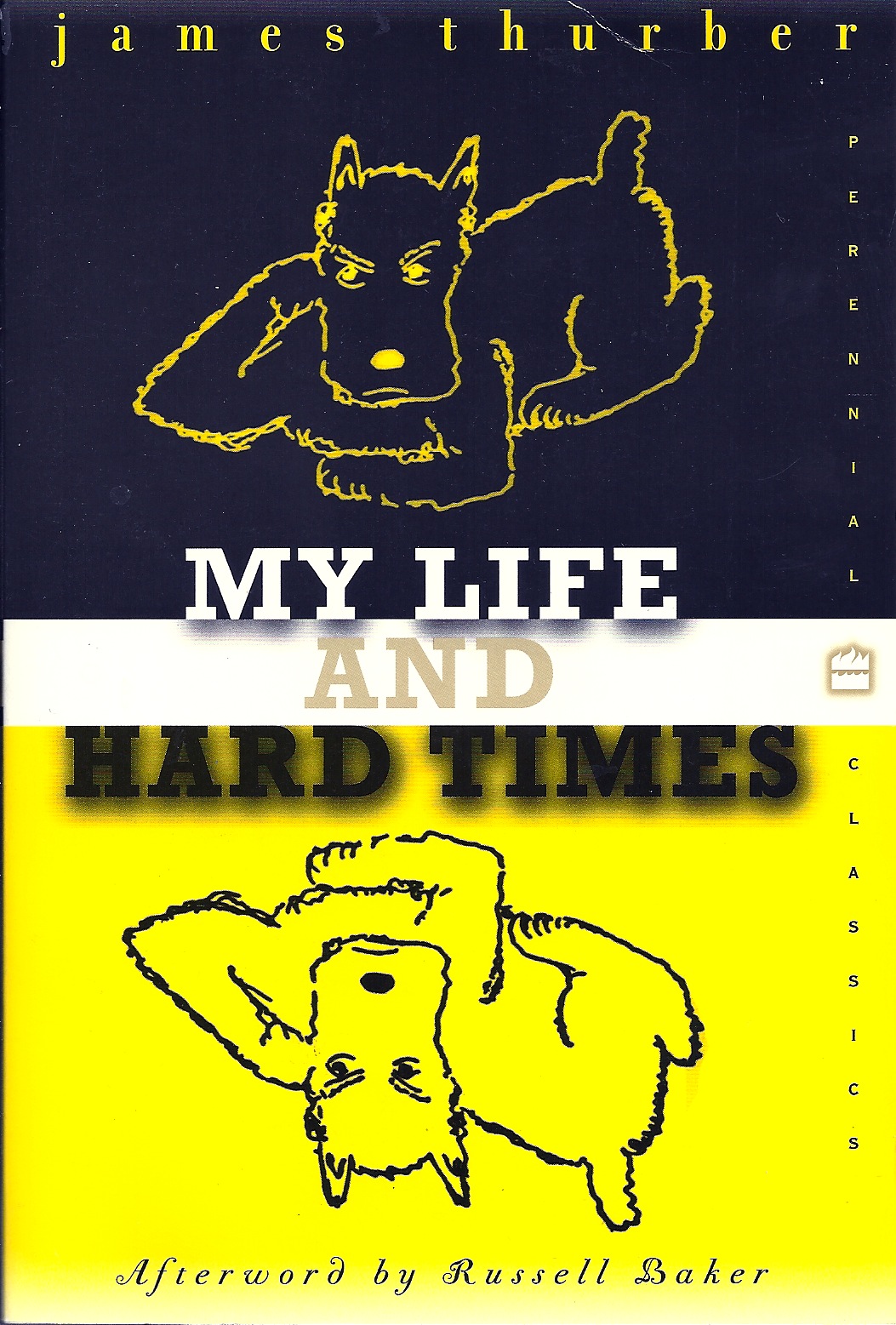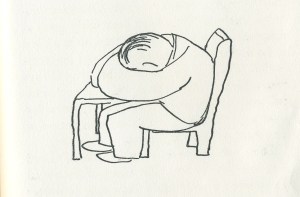
James Thurber
My Life and Hard Times
My Life and Hard Times
“In the early years of the nineteenth century, Columbus won out, as state capital, by only one vote over Lancaster, and ever since then has had the hallucination that it is being followed, a curious municipal state of mind which affects, in some way or other, all those who live there (Thurber ixx).”
Surely the unofficial spokesperson for Columbus, Ohio since the publication of his autobiographical farce My Life and Hard Times is James Thurber. Inspired by the life and “struggles” of his own adolescence on the East Side, this farce provided an identity for his hometown that has long been the subject of appropriate pull quoting and name dropping for columnists of the area for decades.5 Yet for a hometown hero, Thurber’s portrayal of Midwestern life is far removed from the usual sugar-coating you see in a lot of regional literature. He personifies his city for its collective inferiority complex, stocking his text to the brim with accounts of superstition, boredom, fear of the weather, and unique mental unrest. For example, “In the early years of the nineteenth century, Columbus won out, as state capital, by only one vote over Lancaster, and ever since then has had the hallucination that it is being followed, a curious municipal state of mind which affects, in some way or other, all those who live there” (Thurber 67). Certainly, such passages bring us to question: how does a writer so willing to address the insecurities of his region become such a glorified image of the city? The answer lies in the combination of what the city demands and what Thurber supplies. His ongoing presence of certain palpable social qualities, often mistaken as flaws, Thurber effectively brings to focus through his characters. Yet through it all, he portrays eccentricity of character and situation as a life enhancing quality rather than something to be reconciled. Being at odds with the conventions of the commonplace becomes a positive value for the city, the neighborhood, the family, and ultimately the self in Thurber’s case. Columbus, a town in need of confirmation, can effectively overcome its imperfections as long as they are addressed, made to look charming, and delivered through comedy and laughter.
Tangible, bizarre qualities of Thurber’s family and Columbus locals are not so much revealed as preserved by their corresponding interactions in

My Life and Hard Times. Despite Thurber’s affinity for exaggeration, the flat, funny characters doing much of Thurber’s bidding each share that their depictions (though diverse) are always palpable, always backhandedly complimentary and reinforce one another’s identity with confirmation and delight. “The Night the Ghost Got In” is one such story where the farce is evenly spread from character to character. The story begins with a short introductory paragraph that prepares readers for the more colorful events that will unfold in the pages to come—his mother throwing a shoe through a window, his grandfather shooting a policeman—and then goes right into the events of that night. When young Thurber emerges from a bath tub at one in the morning and hears the sound of footsteps in the dining room, he alarms his mother, who alerts the neighbors (hence, shoe hurling), who then call the authorities, who arrive shortly after, only barge into the burglar-less home on Jefferson Avenue (except for the characters aforementioned of course). Eventually, each of these characters would arrive at the conclusion that this burglar must have been a ghost.6 Though some would consider these and similar circumstances that unfold in My Life and Hard Times as a pseudo-mockery, the deliberate inclusion and balance of impartial caricaturizations look and feel non-threatening to the integrity of Columbus and its residents. The Columbus local officers, particularly dopey, ransack through private possessions etc and greet young Thurber in a strong colloquial accent, “‘Whatta you doin’ here?’ He demanded. ‘I live here,’ I said (Thurber 59). The nonsensical actions leading up to the arrival of Columbus’ finest are reinforced rather than discouraged by the image of these officers, lacking any ability to claim superiority by comparison. “‘No sign o’ nuthin.’ Said the cop who had first spoken to mother. ‘This guy,’ he explained to the other, jerking a thumb at me, ‘was nekked. The lady seems historical’” (Thurber 63). Ultimately, if Thurber wished to portray his life, his family, his experience, his town, his neighbors, as inferior, he could very easily have done so by presenting more valid antiheroes. However, every character and event in this book is equally farcical. Even in the midst of all the shoe hurling, ghost hunting, car pushing, and flash “flooding” that compose his fictional autobiography, Thurber places these events in a consciously controlled way that never feels out of place within his own work, and his own life. He surrounds strangeness with strangeness and absurdity within greater absurdity. Within the world of Thurber, farces and exaggerations feel somewhat normal, real and valid within themselves.
Another story, “The Night the Bed Fell” plays out in an equally chaotic fashion to “The Night the Ghost Got In,” with a look and feel that is strikingly similar in plot structure, narrative subjectivity, and overall pace. More a narrative than a memoir, the story written in the first person has a subjective angle, and is ordered chronologically and methodically. There are seven main characters, including James (once again taking the helm as the narrator) and several other family members such as his mother, father, two brothers, cousin, uncle, three aunts, and his grandfather all of whom separately and equally fascinating farces.While the organized chaos of “The Night the Bed Fell” remains focused primarily on the shenanigans and extremities of Thurber’s immediate family—with no neighbors welcomed with shoes, no “authorities” alerted—despite this exclusion of outside forces, the family itself provides the same delightfully entertaining and quietly charming image of his urban upbringing in Columbus. The plot starts with James Thurber explaining his “interesting” family, including a crazy cousin that thinks he will die of suffocation during his sleep, and a grandfather that leaves the house for several days, coming back talking about a war that happened decades ago. When James sets the story in motion as he falls out of his army cot, his mom mistakes the crash for his father’s death and story starts to get chaotic. Upon hearing the sound of James’ “tremendous banging crash” (Thurber 7) which left young James unconscious, unhurt and unassuming, the racket awakened his mother in the next room who immediately came to the conclusion that “her worst dread was realized and the bed in the attic had fallen on father” (which it hadn’t). The noise of his mother’s screaming awakens adjacent and perpendicular rooms within the house, all explicitly detailed to be on the same floor,7 thus leading to each character’s individual fears to act themselves out in collectively individualized, and synchronized hysteria. This would include the suffocation of a cousin (who had a fear of dying in his sleep), the yelping of the family dog Rex (who had an affinity of biting people on a whim), and again some shoe hurling—this time limited to the hallway—of Aunt Gracie Shoaf convinced that the commotion had been caused by the entrance of a burglar (her own respective phobia). Again, Thurber utilizes this butterfly effect we’ve seen before, and organizes chaos and its butterfly effect this time limited to his house and his family. All the while, the events are brought about as a means of entertainment with mistakes easily corrected and clarified by stories end, “The situation was finally put together like a giant jigsaw puzzle. Father caught a cold from prowling around in his bare feet but there were no other bad results.” (Thurber 15). Here where the lack of an anti-hero, or a more commendable clear-headed presence is lacking once again (this time to its complete absence even more so than depicted in “The Night the Ghost Got In”) each of the respective shenanigans, imperfections, misunderstandings, and caricatures continue to interact and reinforce the mindset Thurber hopes to instill in his reader: these mistakes are likable as long as they are brought to the correct focus. This is the mindset that would later be applied in other stories that feature similar misunderstandings and imperfections. Specifically, in this story these compounding and reinforced imperfections are ultimately charming because of their harmless results and playful recitation, despite the fact that such imperfections could easily have been viewed in a negative way had they been inappropriately handled on Thurber’s part. Thankfully for his sake, his family’s sake, and his hometown’s sake, he again presents his material as an organized chaos.
 |
| James Thurber with Peggy Cass and Joan Anderson |
Yet this does not diminish the fact that these depictions are dependent on the reading of material that is, at least on the surface, unflattering. Though at times readers could confuse characterizations of Thurber the writer as mockery, Thurber the illustrator makes clear where his sympathies lie. The depictions of his characters are understated, blemished, and charming but most importantly the descriptions included in the language are always paralleled in the image included. The old cliché that a picture is worth a thousand words perfectly complements the delicately handled blemishes of himself, his family and his hometown.





No comments:
Post a Comment